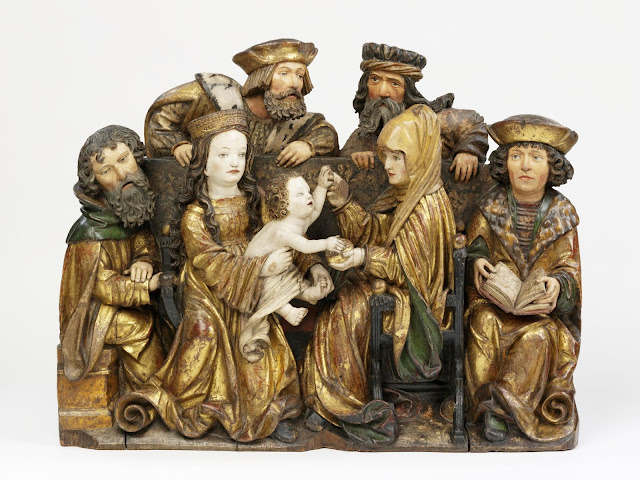 |
| Bernardino Luini, Saint Anne Italian, 1523 Philadelphia, Museum of Fine Art |
July 26th is the feast day of Saints Anne and
Joachim, the parents of the Virgin Mary and the grandparents of Jesus. They, especially St. Anne, have been
important saints for most of the life of the Church and frequently featured in
Christian art.
Over several years I have
posted various images of Saints Anne and Joachim. The number keeps growing because, as the
internet becomes a more widely available tool, the number of museums and
libraries that are making their collections available online keeps
growing. Further, museums and libraries
that were early participants in making collections available by releasing parts
of their holdings keep adding to their online presence. Since Anne and Joachim have been important
for so long, we are still only seeing the tip of the iceberg of images that
probably exist.
Each year I propose to continue to add to the collection
of images available through this blog as new ones become accessible. I will endeavor to link these images with
the essays about their iconological type which I did in 2011.
So, now I present the 2016 additions to the iconography of St. Anne.
 |
| Jean Bellegambe, Pregnant Saint Anne French, c.1500 Douai, Musée de la Chartreuse |
 |
| Master of the Getty Epistles, Education of the Virgin Mary from Book of Hours French (Tours), 1525-1540 New York, Pierpont Morgan Library MS M 452, fol. 140r |
 |
| Education of the Virgin (ivory carving) (Chinese?), 17th century Paris, Musée Guimet, Musée national des Arts asiatiques |
 |
| Anna Selbdritt German (Bavarian), 1472 Paris, Musée de Cluny, Musée nationale du moyen age |
 |
| Circle of Daniel Mauch, Anna Selbdritt German, c.1500 Marseille_Musée Grobet Labadie |
 |
| Defendente Ferrari, Madonna and Child with Saint Anne Italian, 1528 Amsterdam, Rijksmuseum |
 |
| Dirk van Hoogstraten, Virgin and Child with Saint Anne Dutch, 1630 Amsterdam, Rijksmuseum |
 |
| Jean Fouquet, Holy Kindred from Hours of Etienne Chevalier French (Tours), 1452-1460 Paris, Bibliotheque nationale de France MS Nouvelle acquisition latine 1416 |
 |
Master of the Legend of Saint Anne, Holy Kindred
Netherlandish, 1475
Philadelphia, Museum of Art
|
 |
| Master of the Legend of Saint Anne, Holy Kindred Netherlandish, 1475 Philadelphia, Museum of Art |
 |
| Attributed to Matthaeus Gutrecht the Younger, Holy Kindred German, c.1500-1510 Philadelphia, Museum of Art |
 |
| Wood Carving, Holy Kindred Austrian (Tyrol), c.1515-1520 London, Victoria and Albert Museum |
 |
| Colin Nouailher, Holy Kindred French, 1545 Paris, Musée du Louvre |
Saint Anne's mother, identified by the name of Emerencia or Emerantia, was often included in the Holy Kindred or the Anna Selbdritt images. But, occasionally, she was accorded an image of her own.
 |
Jan Provost, St. Emerencia, Mother of Saint Anne
Flemish, c.1500
Paris, Musée du Louvre
|
St. Anne, Patron and Intercessor
 |
Bartel Bruyn the Younger, Catharina von Siegen, nee Kannegiesser, with Saint Anne and Virgin and Child
German, c..1565-1575
Philadelphia, Museum of Art
|
Prayer to Saint Anne
"O glorious Saint Ann, you are filled with compassion for
those who invoke you and with love for those who suffer! Heavily burdened with
the weight of my troubles, I cast myself at your feet and humbly beg of you to
take the present intention which I recommend to you in your special care.
Please recommend it to your daughter, the Blessed Virgin
Mary, and place it before the throne of Jesus, so that He may bring it to a
happy issue. Continue to intercede for me until my request is granted. But,
above all, obtain for me the grace one day to see my God face to face, and with
you and Mary and all the saints to praise and bless Him for all eternity.
Amen."